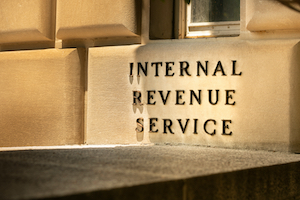The IRS has updated the questions and answers it provides concerning coronavirus-related relief for retirement plans and IRAs. It also has added information on issues pertaining to partial termination of a qualified retirement plan under Section 209 of the Taxpayer Certainty and Disaster Tax Relief Act of 2020. 
CARES Act
The IRS notes that in general, Section 2202 of the Coronavirus Aid, Relief, and Economic Security Act (CARES Act), enacted on March 27, 2020, provides for expanded distribution options and favorable tax treatment for up to $100,000 of coronavirus-related distributions from eligible retirement plans—certain employer retirement plans, such as section 401(k) and 403(b) plans, and IRAs—to qualified individuals, as well as special rollover rules regarding such distributions. Section 2202 also increases the limit on the amount a qualified individual may borrow from an eligible retirement plan, not including an IRA, and permits a plan sponsor to provide qualified individuals up to an additional year to repay their plan loans.
The Q&A address:
- Who a qualified individual for purposes of Section 2202 of the CARES Act is.
- What constitutes a coronavirus-related distribution.
- Whether one:
- has to pay the 10% additional tax on a coronavirus-related distribution from z retirement plan or IRA;
- has to pay taxes on coronavirus-related distributions; and
- may repay a coronavirus-related distribution.
- What plan loan relief is provided under Section 2202.
- Whether:
- it is optional for employers to adopt the distribution and loan rules of Section 2202 of the CARES Act;
- Section 2202 provides additional distribution rights to participants or otherwise changes the rules applicable to plan distributions;
- an administrator may rely on an individual's certification that the individual is eligible to receive a coronavirus-related distribution;
- an eligible retirement plan is required to accept repayment of a participant's coronavirus-related distribution; and
- employees who participated in a business’s qualified retirement plan, then laid off because of COVID-19 and rehired by the end of 2020, are treated as having an employer-initiated severance from employment for purposes of determining whether a partial termination of the plan occurred.
- How qualified individuals report coronavirus-related distributions and how plans and IRAs report coronavirus-related distributions.
The IRS says that it and the Treasury Department are formulating guidance on Section 2202 and to release it “in the near future.” It further says that it expects to apply the principles it followed in IRS Notice 2005-92, in which it provided guidance on the tax-favored treatment of distributions and plan loans under Sections 101 and 103 of the Katrina Emergency Tax Relief Act of 2005.
Taxpayer Certainty and Disaster Tax Relief Act of 2020
The IRS says that Section 209 of the Taxpayer Certainty and Disaster Tax Relief Act of 2020 provides that a plan is not treated as having a partial termination during any plan year which includes the period beginning on March 13, 2020, and ending on March 31, 2021, if the number of active participants covered by the plan on March 31, 2021, is at least 80% of the number of active participants covered by the plan on March 13, 2020.
The IRS says that for purposes of Section 209, a reasonable, good-faith interpretation of the term “active participant covered by the plan,” applied in a consistent manner, should be used when determining the number of active participants covered by a plan on March 13, 2020, and March 31, 2021.
If any part of the plan year falls within the period beginning on March 13, 2020, and ending on March 31, 2021, then Section 209 applies to any partial termination determination for that entire plan year.
The IRS says that the 80% test is not applied by identifying the pool of active participants covered by a plan on March 31, 2021, and determining whether at least 80% of those same individuals were active participants covered by the plan on March 13, 2020. Rather, Section 209 is applied by counting the number of active participants covered by a plan on each of those two dates. The number of active participants covered by a plan who are counted on March 31, 2021, includes all individuals who are active participants covered by the plan on that date, regardless of whether those same individuals were active participants covered by the plan on March 13, 2020.
The IRS also says that Section 209 does not apply solely to reductions in the number of active participants covered by a plan that are related to the COVID-19 national emergency. It adds that although the first day of the statutory determination period—March 13, 2020—is the date the COVID-19 national emergency was declared, the provision’s terms are not limited to reductions related to the COVID-19 national emergency.
- Log in to post comments
